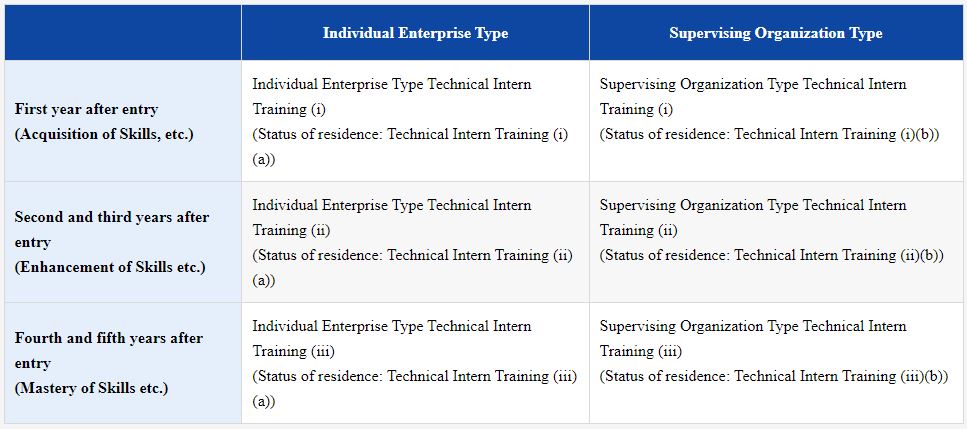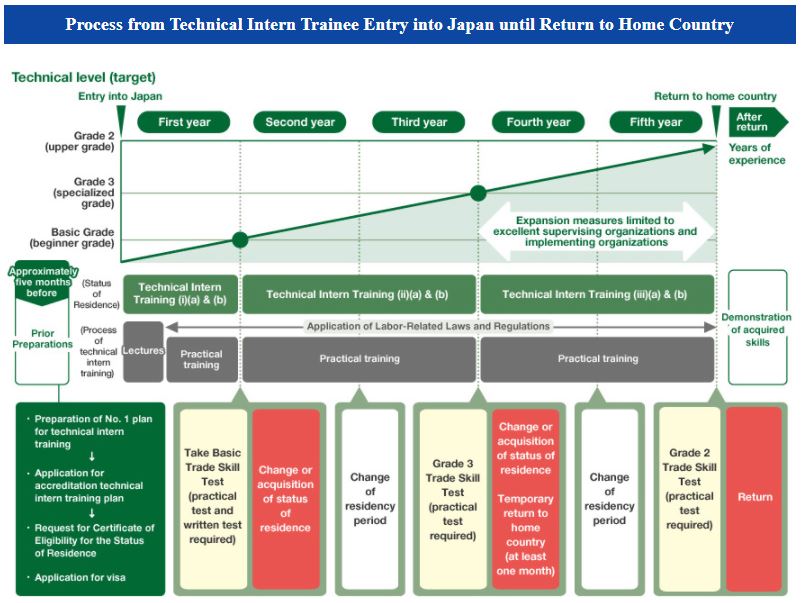Japan’s Technical Intern Training Program (TITP) is a job training program that provides foreign people with employment prospects in Japan. Its purpose is to provide training, technical skills, and technology experience for workers from emerging economies, and it is administered by the Japan International Training Cooperation Organization (JITCO).
Now that travel restrictions are slowly being eased in most parts of the world, including Japan, one of the easiest ways to enter this Asian powerhouse is through a trainee visa, granted upon applying under the Technical Intern Training Program (TITP).
In this guide, we will share everything there is to know about the country’s Technical Intern Training Program. If you’re among those who are interested to participate in this program, make sure to read until the end of this guide.
Contents
- Japan Technical Intern Training Program: Everything You Need To Know
- What Is The Japan International Training Cooperation Organization (JITCO)?
- The Technical Intern Training Program: What is It?
- Technical Intern Training Program: Overview
- How Are Technical Intern Trainees Accepted Into The Program?
- What Are Technical Intern Training Categories and Status of Residence?
- What Is The Process From Technical Intern Trainee Entry into JAPAN until Return to Home Country?
- Tips On Applying For The TITP:
- VIDEO: How To Find Work In Japan Through The TITP
- Final Thoughts
Japan Technical Intern Training Program: Everything You Need To Know
This TITP is a government-run internship program, which began in 1993, intends to assist the international collaboration initiative. However, the program has not been without criticism, as non-payment of wages and a terrible working environment are problems in some workplaces.
So don’t expect a perfect program, but at least the government is now getting their act together. Hopefully, you get an employer who’s fair and provides top-notch training as you fill the role that they need in their company. You will basically be working under the ‘training’ status but you will receive salary and other benefits as a resident of Japan (more on this as you go through the rest of this guide). Also, the time you spend in this country, whether as a trainee, a student, or a worker, will count as valuable experience should you decide to pursue a long-term role or position in any company here in Japan. Moreover, your experience in this work culture as well as your language skills will be an edge when you decide to take your talents elsewhere!
What Is The Japan International Training Cooperation Organization (JITCO)?
The Japan International Training & Cooperation Organization was established in 1991. It was incorporated under the authority of the Cabinet Office in 2012. JITCO promotes the acceptance of foreign nationals into the workforce.
JITCO provides various support services to everyone involved in the Technical Intern Training Program (TITP), including supervising organizations, implementing organizations, and sending organizations, as a program-wide general support organization.
These services include holding seminars, handling individual consultations, and developing and providing teaching materials. JITCO also provides training courses for supervisors at overseeing organizations and technical intern training managers at implementing organizations as the training organization designated by competent ministers by public notice.
As of April 2019, JITCO has a support services program for the status of residence of skilled workers. This new feature was introduced to provide a better support system for the program participants.
The Technical Intern Training Program: What is It?
The Technical Intern Training Act was enacted on November 28, 2016. It provides for the training and protection of technical interns.
The Technical Intern Training Act was enacted following a review of the program. As a result, some portions of the Immigration Control Act were also amended to include the Technical Intern Training act.
The Technical Intern Training Program was created to promote the proper implementation of the Technical Intern Training Act and to protect the interests of technical intern trainees.
Technical Intern Training Program: Overview
The Technical Intern Training Program was established in 1993 to provide training programs that were conducted by local and foreign companies. It was based on the evaluation of the programs conducted by these firms.
The objective of the Technical Intern Training Program is to transfer knowledge and skills accumulated in Japan to developing regions and promote international cooperation. Not only will this benefit employers and workers, but even the countries where these workers come from due to the transfer of technology, skills acquisition and work experiences they bring to society.
The objectives and purpose of the Technical Intern Training program have remained the same since its establishment in 1993. The program is designed to provide technical training to individuals who are interested in working in technical fields.
Furthermore, the Training Program is aimed at developing employment relationships between employers and technical interns in order to allow them to acquire the necessary skills and master them. This program is usually carried out for a maximum of 5 years.
How Are Technical Intern Trainees Accepted Into The Program?
Individual enterprise type and supervising organization type are the two types of procedures for accepting technical intern trainees.
Individual enterprise acceptances accounted for 3.6 per cent of all acceptances as of the end of 2016, while supervisory organizations accounted for 96.4 per cent (based on the number of technical intern trainees present in Japan).
- Individual enterprise type: Employees of foreign local subsidiaries, joint venture companies, or trading partners are accepted for technical intern training by enterprises and other businesses in Japan (implementing organizations).
- Supervising organization type: Technical intern trainees are accepted for technical intern training at associated enterprises by non-profit organizations such as business cooperatives and societies of trade and industry (supervising organizations and implementing organizations).
After they enter Japan, the technical intern trainees go through various lectures to acquire the necessary knowledge and skills to protect themselves from possible legal repercussions. They then apply these learned skills to their employers.
What Are Technical Intern Training Categories and Status of Residence?
For both the individual enterprise type and supervising organization type trainee acceptance formats, there are three technical intern training categories: activities for skill acquisition in the first year after entering Japan (Technical Intern Training I activities to enhance Skills, etc. in the second and third years after entering Japan (Technical Intern Training (ii)), and activities to master Skills, etc. in the fourth and fifth years after entering Japan (Technical Intern Training (ii)).
The following table shows the residency statuses for the various technical intern training categories.

Here are the job categories eligible when interns shift to Technical Intern Training (ii) (JP)
Organizations that can provide Technical Intern Training (iii) are limited to good supervising and implementing organizations that are regarded to meet the responsible ministries’ standards.
New Technical Intern Training Program (JP)
What Is The Process From Technical Intern Trainee Entry into JAPAN until Return to Home Country?
Under the new Technical Intern Training Act, the major aspects of the procedure from technical intern trainee arrival into Japan to repatriation to the trainee’s home country are depicted in the diagram below.

For technical intern trainees to be accepted under the supervising organization type program, the supervising organization must submit the following documents: an application for supervising organization license (for the first time trainees are accepted), an application for accreditation of the technical intern training plan to the Organization for Technical Intern Training, and an application for a Certificate of Eligibility for the Status of Residence to the Immigration Bureau, in that order.
Tips On Applying For The TITP:
When looking back at the previous year’s challenges, the main reason was that both the sending and accepting parties sent/accepted trainees and technical intern trainees did not have a thorough understanding of the program. The program’s goal is to reject inexperienced workers and those looking for a quick buck. In this section, we highlight numerous points that anyone interested in technical intern training in Japan should be aware of.
- Establish a sufficient understanding of the TITP.
The goal of the TITP is to develop human resource development through the use of vocational and industrial skills acquired in Japan. This program is only for individuals who want to study in Japan.
- Pick up basic Japanese.
This is very important for a technical intern to learn Japanese in order to acquire the necessary skills to live a healthy and safe life in Japan.
For one, learning Nihongo diligently will help you avoid getting into a situation where you are not able to pass the National Trade Skills Tests due to your lack of knowledge in Japanese.
Two months before you go to Japan, there are certain laws and regulations that you need to follow before coming to the country. These regulations apply to both foreigners and locals. And as part of your immersion training, you need to know what these are and be able to adhere to them effectively as a soon-to-be resident in the country. For this purpose, learning even basic Nihongo will be crucial – so take this seriously!
- Grasp an idea of what it’s like to live in Japan.
During his or her stay in Japan, a technical intern will need to know the country’s various laws and regulations. This includes rules when riding a bike and driving across the country.
You should also learn how to use various electronic platforms and how to get around efficiently. It is also important to learn how to behave properly when dealing with people. All these, you can study and research online. You just have to devote yourself and dedicate some time to learning these things. Part of your adjustment starts at home – how do you interact with people? What are the do’s and don’ts? What do people consider important on a day-to-day basis?
- Maintain good health.
Climate, natural environment, lifestyle, food, religion, national character, and language are all examples of distinctions between Japan and your own country. To adapt to living in Japan and focus on activities that will help you learn new skills, you must be in good physical and mental health. As you may have learned from this guide, Japanese employers are very strict when it comes to health. Why? Because they are investing in your training, so you should value your health as much as they do. Start to do things right and live right: eat well, sleep early, exercise regularly, and keep an eye on your overall wellness by getting regular check-ups before and during your training period. All these will be crucial to the success of your stay in the country.
- When signing an employment contract, pay close attention.
Under the new TITP, a technical intern must sign an employment contract with a Japanese accepting company before entering the country.
After being selected as a technical intern for a Japanese company, you have to sign a contract. This section explains some of the most important points to pay attention to when signing a contract:
- Confirmation of job information
A sending organization begins recruiting technical intern trainee applicants after receiving job information from a Japanese accepting organization. If technical intern training suits your goals, we propose that you apply for a position as a technical intern trainee after receiving your family’s permission. When applying for a job, it’s critical to double-check the content of the job description. You should pay special attention to the following points:
- Kind of work to be engaged in (type of occupation)
- The site where technical intern training will be implemented
- Working hours per day
- Working hours per week
- Estimated wage per month
- Various deduction amounts
- Signing an employment contract with a Japanese company that accepts you.
After you have been selected for the technical intern trainee position, you will be required to pass the written examination and interviews. Upon successful completion of these tests, you will be hired by the Japanese accepting company.
- Confirmation of the content of the employment contract
When you sign an employment contract, make sure that you understand the terms and conditions of the contract. This will help avoid making mistakes and miscalculations.
If the conditions are not acceptable to you, then you need not sign an employment contract. This means that you have fully understood the terms and conditions of the employment contract, as outlined below:
- Employment contract period
- Place of employment
- Kind of work (occupation, selective work)
- Working hours, etc.
- Days off and leave
- Wage
- Termination of employment
- Social insurance, labor insurance, medical examination
- Signing of contract with sending organization
Upon reaching the stage of the final examination, a technical intern trainee will sign a dispatch contract with the company that accepts them. This contract sets the rights and duties of the intern trainees. Be sure to read and understand the content of these documents and keep a copy of them with you for reference.
- Treatment during the lecture period
Since lectures are provided for free by accepting organizations upon entry into Japan, it is important that they are given before companies start implementing technical internship training. Make sure that you undergo some sort of orientation and training in the workplace even before the start of your formal training.
VIDEO: How To Find Work In Japan Through The TITP
In this video, the featured OFW talked about the technical intern training program in Japan, what it is, and how to be part of it.
He starts off by talking about the various ways you can apply for the TITP. According to him, the only way to apply to get into the TITP is through an agency. There are several agencies you can find in the Philippines, but make sure that you look for one who is accredited and is authorized to operate in the country.
Next, he moves on to explain the procedures. So what are these? First, you have to apply either online or in-person. Once your application has been approved, you will undergo an initial interview and then you will need to take an examination, which is mostly math. And the next step is the medical exam. This will determine if you’re fit to work in Japan followed by the employer’s interview. This could be in-person or virtually (e.g., Skype). After that is the hiring process. You will then have to complete the documentation process waiting for your Certificate of Eligibility (COE).
And then you’ll have to undergo Nihongo training. This takes place while waiting for the result of your COE. At the same time, you will also have to complete your medical examinations in the country. And then finally, after your COE has been released and you have been cleared from your medical examination, you will then have to process your visa.
The vlogger shared some tips on taking the medical exam is you have to know that the Japanese government is very strict when it comes to health. So even if you were able to pass all the training requirements, but in the end, failing the medical exam you will not be allowed to pursue the training. So make sure that you’re fit to work before you apply for training in Japan, whether as a trainee or as an employee for a private company. One of the common pitfalls of trainees applying for work in Japan is the medical exam. Most of them fail because of poor health and undetected diseases such as fatty liver caused by excessive alcohol intake and excessive consumption of fatty food. So make sure that you keep a healthy diet and avoid drinking alcohol before you apply for the training or before you undergo a medical examination. This is to ensure that you will have the best results by the time that you undergo your exam.
Next would be the Nihongo training this training takes about two to four months depending on the institution that you will be training with. Some agencies have partner schools, so they would cover all of your training needs and expenses during this time. But in preparation for the training, which is about two to four months, you need to have some funds. In the vlogger’s case, he prepared at least 30,000 pesos. This is to cover his accommodation, food, basic supplies, and of course, their medical exams (there are several). Of course, this would vary on how you save up or spend your money. But, it’s important that you have some stash to keep you going during this time. And while learning Japanese make sure that you study seriously. Practice as much as you can. And do not be afraid if you make mistakes. Do note that even when you get to Japan, you will still continue learning. The good news is, the Japanese are very considerate to those learning the language, unlike us, Filipinos. With all these tips, you should be able to get on your TITP journey as seamless as possible.
Final Thoughts
Working in Japan is truly a dream for many Filipinos. Despite the setback caused by the pandemic, many Filipinos still wish to find work abroad, especially in countries like Japan. With the number of cases slowly coming down in the country, there is now hope for Filipinos who wish to enter the country for work as a trainee or for studying, but not yet for tourists. With this guide on hand, you now have a better idea of what the Technical Intern Training Program (TITP) is, how the Japan International Training Cooperation Organization (JITCO) plays a big role in the processing of training applications, the process of training application as well as the options you have in becoming a trainee in Japan. We also looked into the training categories and residence status that you may receive as you apply for a training position there. And then we also looked at the overview of getting into Japan as a trainee, as well as what happens when you go back to your homeland after your training period, which lasts from two to four years. Finally, we shared some tips when applying for the TITP, as backed by the experiences shared by the featured OFW in the video we shared.
We hope that you’ve found this guide to be useful in your Japan training journey. And hopefully, in the future, you become one of the successful trainees who participated in this program which was established with the Japanese government in partnership with the various countries that it deals with, including the Philippines. Meanwhile, if you have experienced becoming a grantee of this training program, we would love to hear from you. What was the experience like? Please leave a message in the comment section below.
READ NEXT: Here’s What You Need to Know about Japan’s New Specified Skills Visa

